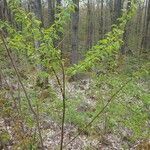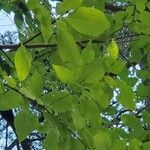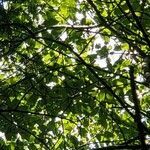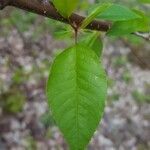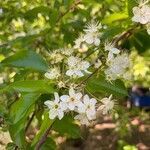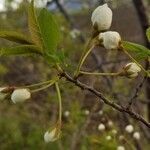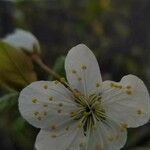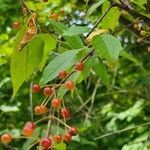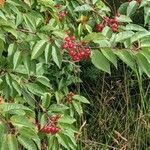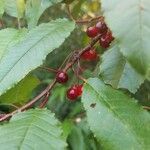Shrubs or trees, often suckering, 20–160 dm, not thorny. Twigs with terminal end buds, glabrous. Leaves deciduous; petiole (7–)9–20 mm, glabrous, glandular distally, glands 1–3; blade elliptic, oblong-lanceolate, or lanceolate, (2.5–)4.5–10(–14) × 1.5–5 cm, base cuneate to rounded, margins crenulate to crenate-serrate, teeth blunt, glandular, apex usually acuminate, sometimes acute (western specimens), surfaces glabrous. Inflorescences 2–5(–8)-flowered, umbellate fascicles or corymbs; central axes 0–8(–24) mm. Pedicels (8–)10–30 mm (subtended by minute bracts), glabrous. Flowers blooming at leaf emergence; hypanthium obconic, 1.8–3 mm, glabrous externally; sepals reflexed, oblong, 1.2–2.8 mm, margins entire, surfaces glabrous; petals white, elliptic, obovate, or suborbiculate, 4–7 mm; ovaries glabrous. Drupes bright red, ellipsoid, 6–10 mm, glabrous; mesocarps fleshy; stones ellipsoid, not flattened. 2n = 16.
More
A small tree. It grows to 12 m high. The trunk is 25 cm across. The bark is smooth, shiny and dark reddish-brown. The leaves are sword shaped and 8-15 cm long. They taper gradually to a slender sharp tip. The leaves are thin and fragile. There are very small uneven teeth around the edge. The flowers are white and attractive. They occur in clusters of 4-7. The fruit occur in clusters and are dark red. They are on long stalks. The fruit are 6-8 mm across. The flesh is edible. It is sour.
Forming thickets along streams and lakeshores, in clearings, roadsides, burned-over areas, disturbed sites, rocky hillsides, cliffs, open forests; at elevations up to 2,800 metres. Prefers wet woodlands, old tamarack bogs and interdunal swamps.
More
It cannot tolerate shade. It can tolerate drought. Temperate. It suits hardiness zones 2-9.
